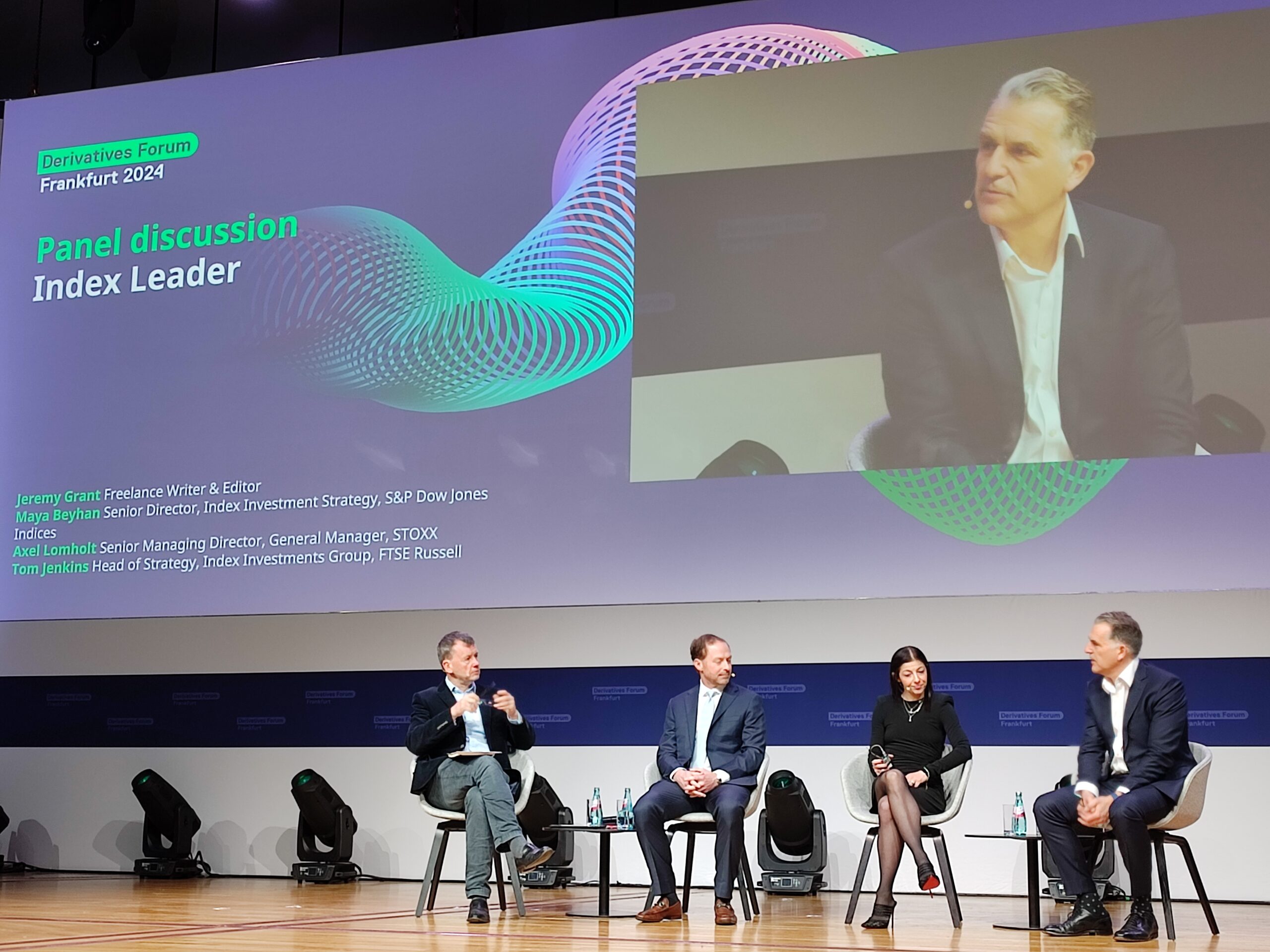A panel at the recent Eurex Derivatives Forum in Frankfurt discussed the three key forces transforming index providers: investment customization, portfolio diversification and sustainability.
These three trends combine to drive product design as indexing takes center stage over so-called active investing.
“Indices used to be performance measurement tools,” Axel Lomholt, General Manager at STOXX, said during the panel entitled ‘Index Leaders.’ “That’s not the way the world is operating anymore. It’s moved to a hyper-customized interaction with clients. You need to build an ecosystem that can cope with that customization that clients demand.”

Driven by heightened regulation, new responsible-investing objectives, and a changing macroeconomic backdrop, institutional investors are seeking solutions that are both tailored and can efficiently help them achieve their very precise targets. Most noticeable within this new paradigm has been the integration of sustainability considerations as a pillar of portfolio construction, the panel concurred.
“We’ve moved from a framework where clients were focusing on risk and return, to focus on risk, return and the real-world impact of the portfolio,” said Axel at STOXX. “We’ve seen not only customization within an index, but clients want to have a customized ESG overlay.”
ESG 2.0
Tom Jenkins, Head of Strategy at FTSE Russell’s Index Investments Group, agreed that those impact considerations have become more deeply engrained in portfolio construction in recent years. While the first sustainability indices focused on removing controversial companies, the new generation integrates ESG considerations more positively.
“If you are very generic, ESG 1.0 was an exclusionary exercise, and we really need to have more of an inclusive exercise,” Tom said. In “ESG 2.0,” clients want indices that look at a company’s management quality, its green revenues and its sustainability performance relative to peers, and reward the impact leaders, he said. “An index that says, here is a model behavior, here is one who is in-flight, and here is one who hasn’t started the process.”
Two immediate challenges arise from this new bespoke trend, the panel said. The first one is how to implement sophisticated methodologies without losing the transparency of indices, a key attribute underpinning the global shift of capital to index-based investments.
“Transparency is a huge component of our collective businesses,” said Tom at FTSE Russell. “If a product is opaque, it is not helpful to the investment community. People need to understand how you reach a point in the final calculation, where the risk-reward is coming from, where the tracking error is being driven from. If you can’t articulate or show that in the public domain, it is really hard to get an option.”
“We also see increasing demand from clients,” added Maya Beyhan, Senior Director for Index Investment Strategy at S&P Dow Jones Indices. “They want to understand what goes on behind those ESG scores. ESG 1.0 was arguably more subjective, more aggregated, less detailed. Whereas now, clients want to know more.”
Investable ecosystems
A second challenge is the need to create liquid investment ecosystems around tailored indices, to help investors manage and hedge their positions.
“How do you take that customized idea and make it available to the masses?” said FTSE Russell’s Tom. “Asset owners want the completion of the ecosystem. So, it’s a push and pull all around.”
Some of those solutions have successfully progressed to exchange-traded markets. This year Eurex introduced futures on the STOXX® Europe 600 SRI, an index with product-involvement exclusionary screens as well as filters to remove the highest-emitting companies and include those with the best ESG scores. DWS last November launched the first ETFs tracking the new ISS STOXX® Biodiversity indices, a suite that integrates nature-related risks and opportunities through a comprehensive approach.
Diversification and 3D investing
The panel also touched upon diversification, a topic of utmost relevance these days as the traditional negative correlation between equities and bonds appears to have broken down.
As investors search for emerging asset classes to allocate capital to, index providers have been at work to determine whether those investments can be indexed with gauges that are tradable and representative of the underlying market.
Axel at STOXX said the traditional formula of investing 60% in stocks and 40% in bonds has changed to one where up to 20% is now invested in alternative assets.
“It’s a meaningful shift that impacts all of us,” said Axel. “When you look at that 20% bucket, it is crypto, private assets, infrastructure. All stuff that historically was not really the domain of index providers.”
Tom at FTSE Russell and Maya at S&P Dow Jones highlighted infrastructure, digital assets and carbon credit futures among investments that are getting more investor interest as they seek to diversify exposures.
“The big thing in diversification is: it’s not about the risk and returns of all those asset classes, but it’s how does this portfolio impact the real world?” said Axel. “It’s 3D investing. For me, that is the biggest shift we’ve seen in years.”
Overall, the panel was an excellent opportunity to hear insiders’ perspectives in an industry immersed in change and shaping the way asset owners invest their capital. Index providers have become key partners for investment institutions as the latter adapt their portfolios to modern requirements. This partnership is likely to keep fostering innovation and bringing efficiencies in asset management.
